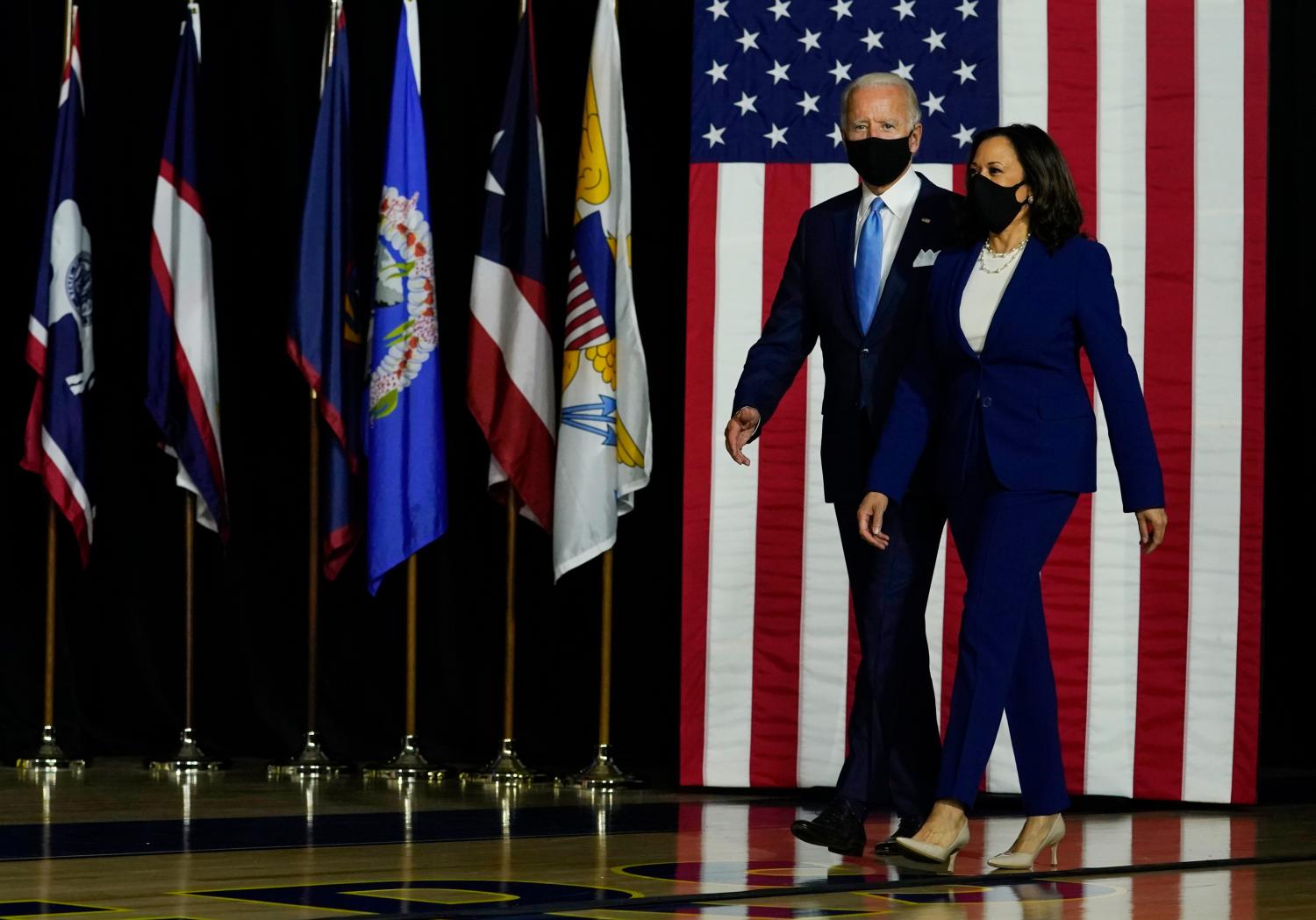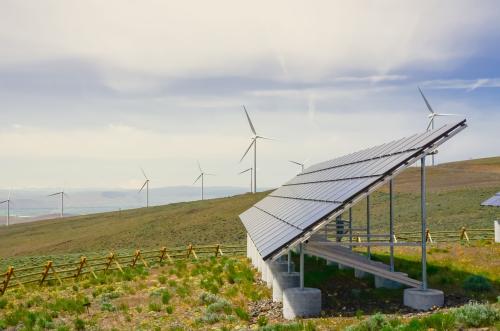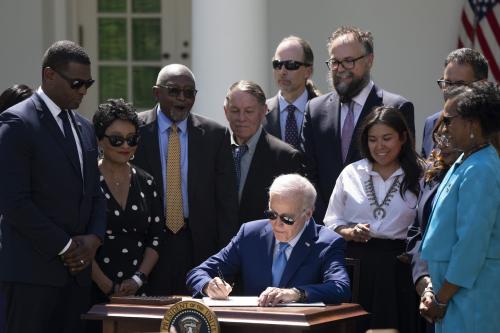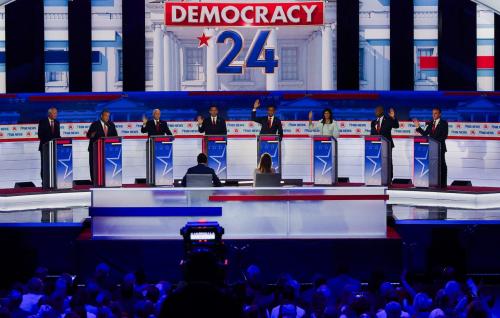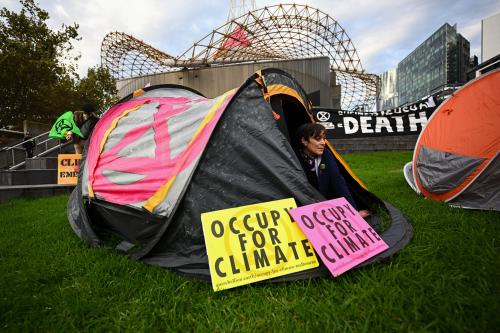Summary
As the U.S. federal government reengages with international climate policy, it should not retire the groundswell of city, state, business, and community climate action that has held the line for the last four years, but incorporate it into a reinvigorated “all in” climate diplomacy. Specifically, the Biden-Harris administration should:
- Leverage climate action across all of society to ensure that U.S. climate targets represent maximum ambition while highlighting credible pathways to implementation
- Integrate U.S. subnational and nonstate climate action into diplomacy, moving from simply highlighting the scale of non-federal action to actively incorporating it into operational strategies
- Create institutional structures in the State Department and the federal organizing architecture, which may include a new National Climate Council, to empower U.S. cities, states, businesses, and communities to drive climate action not just at home but also globally
Introduction: The United States is all in
Climate is a top priority for the incoming Biden-Harris administration. But the new president and vice-president will face two major challenges to deliver on this core promise. Domestically, they will have to advance policy in the context of a Senate that will either remain under Republican control or hang on a knife-edge majority, and under the shadow of an unsympathetic Supreme Court. Internationally, they will have to convince the world that the U.S. can be a trustworthy partner after dropping out of international climate pacts for the second time this century.1
To deliver, the administration needs an “all in” climate policy that finds new ways to advance an ambitious national strategy, including by leveraging the power of the states, cities, businesses, investors, and communities that have held the line on climate action for the past four years. Together this groundswell of non-federal actors accounts for over half of U.S. emissions, 65 percent of the population, and nearly 70 percent of U.S. GDP.2 While these efforts cannot replace federal action, they have already created the basis for a stepped-up federal response. They are well-positioned to help the administration go further, faster as the country recovers from the COVID-19 crisis and aims to invest in the transition to a cleaner, fairer, more resilient economy.3 With Washington now on their side, it is time for non-federal climate actors not to step down, but to level up.
An “all in” approach can strengthen a revamped U.S. climate diplomacy under the Biden administration in several ways. Fully leveraging non-federal climate action can allow higher national ambition—and in doing so, enable the U.S. to bring higher targets to the international table. Those targets will also be seen as more credible because they are embedded not just in the priorities of one administration, but in the society and economy of the United States as a whole. And beyond top-line numbers, institutionalizing a stronger role for cities, states, business, and communities on the operational side of climate diplomacy can expand the foreign policy toolkit on issues ranging from green infrastructure to climate justice. In this way, an “all in” approach reminds the world that America’s openness and diversity in its society, economy, and political system are assets, not liabilities, in the battle against climate change—what Anne-Marie Slaughter has called “America’s edge.”4
Overcoming the credibility gap to restore American influence
When President-elect Biden and Vice-President-elect Harris return to the international climate stage, they will face skepticism about their ability to deliver not just targets, but action at home and long-term, reliable partnership internationally. Most countries will of course be glad to welcome the United States back to the table, but the new administration will soon face challenges as it seeks to re-establish a mantle of leadership on this issue, and indeed make it a signature policy of a renewed American foreign policy.5 After all, climate policy has not waited for the United States over the last four years. With France, Germany, the U.K., Japan, South Korea, and even China now having announced net zero targets, the U.S. is late to the game. Some countries may view the U.S. as now more of a follower or even a laggard. Returning the U.S. to a visible leadership position will entail deep engagement, highlighting the real actions happening across the country, and building confidence in our ability to deliver long-term.
Given the whipsawing of U.S. climate strategies over the past two decades, most notably in the past four, even the friendliest allies will wonder: Can we rely on the United States after the next presidential election, or the one after that? They will also ask the new administration how it expects to get its policy ambitions through the Senate, whether they can withstand scrutiny from the Supreme Court, and how any emergent national strategy will be at least decently robust against future shifting political winds. Answering this question credibly will be essential to restore influence with allies and competitors alike. On climate, as on all issues, the United States cannot assume the world will allow it to restart the clock in 2016. Leadership needs to be re-earned.
Fortunately, our recent experience of expanding an increasingly ambitious subnational climate action gives the new administration a significant head start. The federal system in the U.S. has allowed action to continue across a broad part of the country, and in this context, the Biden administration can point to significant development of new policies delivered by U.S. states, cities, businesses, and communities. In aggregate, non-federal climate coalitions in the U.S. are equivalent to the world’s second-largest economy, boasting a GDP roughly the same as China’s. Remarkably, current commitments from these actors alone are estimated to be able to help deliver a reduction in greenhouse gasses of 25 percent by 2030.
It is difficult to imagine any other major country where action by subnational and non-state actors could so effectively hold ground—and in some ways, advance—climate policy in the face of a hostile head of state. The Trump administration may have reversed federal, executive branch policies, and menaced and slowed state measures, but the reality is that even the President of the United States could not stop America’s movement toward the goals of the Paris Agreement.6 This goes beyond just government leaders: the American business and financial community has also accelerated their engagement with the climate transition during the last four years, with now over 2,200 businesses and investors joining the We Are Still In coalition. That “all of society” commitment is the new administration’s strongest opening argument for why the United States remains a critical leader on climate policy globally. It provides the foundation basis for a revamped climate policy going forward, and an insurance policy should U.S. federal leadership again become compromised or gridlocked.
International ‘all in’ leadership starts at home
International leadership is fundamentally linked to domestic action at home. While the new administration plans to take forward aggressive executive action, and can be expected to pursue even more ambitious legislation, states, cities, business, and communities will continue to be core pillars of climate policy for several reasons.
First, many cities, states, businesses, and communities will continue to raise the bar of ambition higher and faster than will be possible at the federal level. Moreover, as non-federal actors move to phase out greenhouse gases as soon as possible, they create a stepped-up basis for the federal government to act as well.7 Many federal regulatory actions, for example, use existing state levels of action as an important input as they assess what legislation requires. State policies on, say, renewable portfolio standards or clean electricity targets are critical parts of such considerations and enhanced state levels.
Second, even with the federal government back in a policy leadership role, much concrete implementation will occur at the state and city level, in the private sector, and in communities.8 A key and often under-appreciated dimension of building a federal strategy on subnational actions is that the subnational actions are rooted more firmly in local politics and circumstances, and could therefore be viewed as more resistant to a potential revolving door in the Federal Executive. It also enhances awareness of and commitment to implementation strategies—which will be key in moving from new targets or policies to real emissions reductions.9
Already, a number of concrete steps have been proposed to leverage sub- and non-state action in the next administration.10 For example, the Biden-Harris administration could call on U.S. states, cities, businesses, tribes, faith groups, universities, and others to set their own ambitious targets, and then harvest this new ambition as the U.S. develops and implements its climate strategy.11 The administration could also support these entities to develop robust climate plans, and give them a seat at the table in federal policy development.
Operationalizing ‘all in’ climate diplomacy
While states, cities, businesses, and other actors have a clear role to play at home, they can be just as important players in American foreign policy, The trust and recognition American states, cities, businesses, and communities have built up internationally is a precious diplomatic asset. Beyond providing a foundation of credibility for renewed U.S. climate diplomacy, these actors can make valuable contributions to the day-to-day work of international engagement.
First, while the Trump administration was pulling back, global climate governance shifted to enhance the standing and role of sub- and non-state actors. The U.N. climate regime is pivoting from negotiations to implementation. While a few pieces of the Paris Agreement’s “rule book” remain to be negotiated (most centrally, the rules governing the international exchange of carbon credits), the heart of the U.N. process has now shifted to the 5-year “pledge, review, and ratchet” cycles under the Paris architecture.12 This is the process through which countries make new commitments, review progress, and enhance their commitments at regular intervals. In this system, the importance of concrete action and national ambition rises relative to that of new intergovernmental negotiations. It is concrete outcomes and ambitions that drive the system forward, not negotiated outcomes.
Therefore, the toolkit the new administration’s climate diplomats will need must also change. While diplomats will continue to need to navigate complex multilateral processes to build coalitions in support of U.S. positions, the larger goal will be to shape the ways countries make and implement their climate pledges. Climate diplomacy will be less and less about negotiating legal text, and more and more about galvanizing concrete action. Indeed, the U.N. process is increasingly a platform for brokering and orchestrating action-oriented coalitions, such as the U.K.-led “Race to Zero” campaign or various sectoral campaigns.13 In this context, states, cities, the private sector, and civil society are less and less “observers,” in the traditional U.N. parlance, and more and more “actors.”14 This recognizes that even if formal, U.N.-related decisionmaking authority remains with sovereign states, many other actors are in fact also taking consequential action that drive national and global climate action and emissions reductions.
This transition particularly suits U.S. interests because U.S. sub/non-state actors are climate action leaders globally. The U.S. should support efforts to increase the role of diversified, subnational climate action and implementation as it re-enters the Paris architecture. As it does so, the federal government can simultaneously accept clearly its own responsibility to renew domestic policies at the federal level while also putting its best foot forward by making clear how this diversified climate action is a core element of U.S. strategy and U.S. climate diplomacy.
Second, U.S. cities, states, businesses, and civil society are at the forefront of the global networks of sub- and non-state actors that are major players in international climate policy. Mayor Eric Garcetti of Los Angeles chairs C40, the global network of megacities acting on climate change. The state of California co-founded the Under2 Coalition of states and provinces. Companies such as Amazon and Walmart are playing key roles in pushing sustainability through their supply chains. The “Race to Zero” campaign mentioned above, the flagship initiative for the next U.N. climate summit, has more actors from the U.S. than from any other country. As U.S. diplomats seek to re-engage countries on climate policy, these U.S. climate leaders stand ready as powerful allies. Of particular importance, as the new administration seeks ways to engage China on climate, in the context of a complex broader relationship, the long-standing links between Chinese provinces and cities and U.S. states and cities, and between American companies and Chinese companies, create a useful starting point.
To leverage this “network power,”15 the new administration should seek to mainstream an “all in” approach across its climate diplomacy. We should evaluate each element of U.S. climate diplomacy with the question: could this approach be strengthened by deploying U.S. cities, states, businesses, or communities? For example, how can an American city that has grappled with a legacy of environmental racism share lessons with developing countries where rapid, unplanned urbanization risks creating new injustices? How can big U.S. banks and asset managers that have pledged to go green work with federal agencies like the U.S. Development Finance Corporation (DFC) to offer green alternatives to Chinese-backed coal plants in Southeast Asia? While most sub- and non-state climate action to date has focused on overall goals, the next generation of these efforts should get into the operational details.
Institutionalizing ‘all in’ climate diplomacy
“All in” climate diplomacy is more than just a rhetorical frame. To succeed, it requires tangible changes in the organization of U.S. climate diplomacy. Below we outline some key functions and structures that could advance this approach.
Establish a Climate Action Unit in the State Department or under a new White House National Climate Council. To fully leverage the potential of U.S. states, cities, businesses, and communities, the federal government needs an office that connects the groundswell of non-federal actors to diplomatic priorities. This Climate Action Unit could be based either in the State Department, the lead agency for diplomatic strategy, or, perhaps even more effectively, in a new National Climate Council that could be created. This small team would be charged with facilitating the engagement of U.S. cities, states, businesses, and communities in international climate policy. Such an office could build a sophisticated overview of both U.S. domestic action at the non-federal level and climate diplomacy priorities. Its mandate would be primarily around orchestration and brokering, finding innovative ways to connect these two spheres to advance the administration’s climate objectives, including the international work of a broad range of relevant federal agencies (e.g., Department of Energy, Environmental Protection Agency, Treasury, DFC, etc.). The Climate Action Unit would also be well positioned to facilitate the incorporation of non-federal action into future U.S. pledges under the Paris Agreement and to engage with climate action related events in the U.N. process and beyond.16Appoint U.S. Climate Action Ambassadors. For many areas of climate diplomacy, the best representatives for the U.S. abroad are the mayors, governors, CEOs, and community leaders who are delivering climate action at home. The new administration could designate a team of leading figures in climate action as informal ambassadors for the United States, asking them to devote a portion of their time to advancing U.S. priorities abroad. These Climate Action Ambassadors would be supported and staffed by the Climate Action Unit to ensure that they acquired the necessary information to operate effectively in the international context, and they would report to the administration’s climate policy lead. The Climate Action Ambassadors would be “on call” for representing U.S. interests at key international fora, but could also be tasked with specific deliverables. For example, a governor of Indian heritage could be tasked with mobilizing climate partnerships with a certain number of Indian states, or a major U.S. investor could partner with the DFC to develop a green infrastructure investment plan for Indonesia.
Translating American pluralism into diplomatic power
“All in” climate diplomacy can strengthen the hand of the new administration in international climate policy. But it can also pioneer a broader model for U.S. diplomacy after Trump. Many observers at home and abroad have questioned the ability of the U.S. to respond to complex challenges like climate change or pandemics at a time of renewed geopolitical competition, and in a period of divisive domestic politics. Some have even questioned the ability of liberal democracies in general to address these types of challenges.
“All in” climate diplomacy turns this criticism on its head by showing how diversified domestic approaches, rooted in pluralism, can be strengths. As Rebecca Lissner and Mira Rapp-Hooper note, the openness of American society can be both a strategic asset and an organizing principle for the United States.17 The climate achievements of non-federal actors over the last four years underline this advantage of our system. Going forward, these features of U.S. climate policy can help deliver a more rapid and robust transformation while also making climate policy more resilient to political disruptions. As the Biden-Harris administration looks to make climate change a signature foreign policy priority, it can remind both the country and the world that we are “all in” this together.
-
Footnotes
- President Trump withdrew the United States from the 2015 Paris Agreement, and George W. Bush “unsigned” the 1997 Kyoto Protocol in 2001.
- The America’s Pledge Initiative on Climate Change (2019) Accelerating America’s Pledge. By: Hultman, N., C. Frisch, L. Clarke, K. Kennedy, P. Bodnar, P. Hansel, T. Cyrs, M. Manion, M. Edwards, J. Lund, C. Bowman, J. Jaeger, R. Cui, A. Clapper, A. Sen, D. Saha, M. Westphal, W. Jaglom, J.C. Altamirano, H. Hashimoto, M. Dennis, K. Hammoud, C. Henderson, G. Zwicker, M, Ryan, J. O’Neill, E. Goldfield (2019). New York: The America’s Pledge Initiative on Climate Change and Bloomberg Philanthropies, with the University of Maryland Center for Global Sustainability, Rocky Mountain Institute, and World Resources Institute. 156 pp. consisting of 94 pp. Report, 62 pp. Technical Appendix. Available at: www.americaspledge.com/reports.
- The America’s Pledge Initiative on Climate Change (2020) Delivering on America’s Pledge: Achieving Climate Progress in 2020. W. Jaglom, C. Frisch, K. Kennedy, L. Clarke, N. Hultman, T. Cyrs, J. Lund, D. Saha, J. Feldmann, C. Bowman, J. O’Neill, M. Campton, M. Herbert, L. Calle, A. Light, P. Bodnar. Published by Bloomberg Philanthropies with Rocky Mountain Institute, University of Maryland Center for Global Sustainability, and World Resources Institute. New York. Available at: americaspledge.com/reports
- Anne-Marie Slaughter, “America’s Edge: Power in the Networked Century,” Foreign Affairs, January / February 2009.
- Jason Bordoff, “It’s Time to Put Climate Action at the Center of U.S. Foreign Policy,” Foreign Policy, July 27, 2020, https://foreignpolicy.com/2020/07/27/climate-change-foreign-policy/
- For example, see N. Hultman & P. Bodnar (2018) “Trump tired to kill the Paris Agreement, but the effect has been the opposite.” https://www.brookings.edu/blog/planetpolicy/2018/06/01/trump-tried-to-kill-the-paris-agreement-but-the-effect-has-been-the-opposite/
- For fuller discussions of how sub-national actions can support higher national, and global climate action, including in the U.S., see: Hultman, N.E., Clarke, L., Frisch, C., Kennedy, K., McJeon, H., Cyrs, T., Hansel, P., Bodnar, P., Manion, M., Edwards, M.R., Cui, R., Bowman, C., Lund, J., Westphal, M.I., Clapper, A., Jaeger, J., Sen, A., Lou, J., Saha, D., Jaglom, W., Calhoun, K., Igusky, K., deWeese, J., Hammoud, K., Altimirano, J.C., Dennis, M., Henderson, C., Zwicker, G., O’Neill, J., 2020. Fusing subnational with national climate action is central to decarbonization: the case of the United States. Nature Communications 11, 5255. https://doi.org/10.1038/s41467-020-18903-w Hsu, A., Brandt, J., Widerberg, O., Chan, S., Weinfurter, A., 2020. Exploring links between national climate strategies and non-state and subnational climate action in nationally determined contributions (NDCs). Climate Policy, 20:4, 443–457. DOI: 10.1080/14693062.2019.1624252
- See N. Hultman (2019). Building an ambitious US climate policy from the bottom up, The Brookings Institution https://www.brookings.edu/blog/planetpolicy/2019/12/09/building-an-ambitious-us-climate-policy-from-the-bottom-up/
- For an assessment of US cities’ progress see Sam Markolf, Inês M.L. Azevedo, Mark Muro, and David G. Victor, “Pledges and progress: Steps toward greenhouse gas emissions reductions in the 100 largest cities across the United States,” Brookings Institution, October 2020. Available: https://www.brookings.edu/research/pledges-and-progress-steps-toward-greenhouse-gas-emissions-reductions-in-the-100-largest-cities-across-the-united-states/ For a general framework see Hale, T.N., Chan, S., Hsu, A., Clapper, A., Elliott, C., Faria, P., Kuramochi, T., McDaniel, S., Morgado, M., Roelfsema, M., Santaella, M., Singh, N., Tout, I., Weber, C., Weinfurter, A., Widerberg, O., 2020. Sub- and non-state climate action: a framework to assess progress, implementation and impact. Climate Policy, DOI: 10.1080/14693062.2020.1828796
- See Aimee Barnes, “The Secret Weapon in Biden’s fight against climate change,” The Hill, November 14, 2020. Available: https://thehill.com/opinion/energy-environment/525939-the-secret-weapon-in-bidens-fight-against-climate-change
- See N. Hultman (2020). An open process to increase ambition and robustness of the next U.S. climate target. Published by the Center for Global Sustainability, University of Maryland and The Brookings Institution Washington DC, 12 pp. Available at: https://www.brookings.edu/research/building-an-ambitious-and-robust-us-climate-target/
- Susan Biniaz, “After Madrid, W[h]ither the COP?,” The Sabin Center for Climate Change Law, Columbia University, January 2020. Available: https://climate.law.columbia.edu/sites/default/files/content/docs/Biniaz%202020-%20After%20Madrid%2C%20W%5Bh%5Dither%20the%20COP_FINAL.pdf
- Race to Zero: https://unfccc.int/climate-action/race-to-zero-campaign
- Thomas Hale, The Role of Sub-state and Nonstate Actors in International Climate Processes,” Chatham House, November 2018. Available: https://www.chathamhouse.org/sites/default/files/publications/research/2018-11-28-non-state-sctors-climate-synthesis-hale-final.pdf
- See Anne-Marie Slaughter, The Chessboard and the Web: Strategies of Connection in a Networked World (New Haven: Yale University Press, 2017).
- A related proposal is to create a “Subnational Diplomacy Office,” as envisioned in the ‘City & State Diplomacy Act’ in Congress: https://www.congress.gov/bill/116th-congress/house-bill/3571/text
- Rebecca Lissner and Mira Rapp-Hooper, An Open World (New Haven: Yale University Press, 2020).


